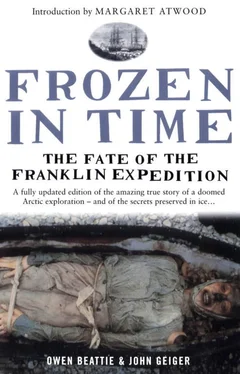Commander George Washington De Long, captain of the 1879–81 Arctic voyage of the U.S. steamer, Jeannette, had taken specific precautions against “debility.” Whilst unconvinced about lime juice’s efficacy, he well understood “the importance attached to it by Arctic medical authorities and Arctic voyagers generally [and] did not care to depart from an established custom.” De Long had three barrels of lime juice loaded aboard the Jeannette. The expedition also carried large stores of canned meats, soups and vegetables.
De Long sought the North Pole, failing which he intended to navigate the Northwest Passage. It would be a privately backed expedition; De Long’s benefactor was a newspaper proprietor, James Gordon Bennett, owner of the New York Herald and the man who also assigned correspondent Henry Morton Stanley to travel to Africa to locate the British missionary Dr. David Livingstone. Bennett’s influence was such that he was able to secure an Act of the United States Congress declaring the Jeannette ’s voyage a “national undertaking.”
De Long had been involved in an earlier cruise into the eastern Arctic, and had written, “I never in my life saw such a dreary land of desolation, and I hope I may never find myself cast away in such a perfectly God-forsaken place.” He was not an Arctic lion either, in appearance (balding, pince-nez) or temperament (he was sensitive and studious), but he had caught a bad case of what his wife termed “the polar virus.”
The Jeannette sailed from San Francisco on 8 July 1879, with a scientific staff that included an astronomer, meteorologist and naturalist from the Smithsonian Institution. Beset by ice on 6 September, she then drifted for two years in the polar pack as sickness gradually tightened its hold on her 33 crewmen. The men were largely dependent on tinned foods, and, as their symptoms worsened to include severe abdominal pain, fear spread that something in their diet was poisoning them. The crew was already in a severely weakened state when the Jeanette was finally crushed by the pack-ice in the Laptev Sea in 1881, though the men escaped, dragging three boats and supplies over hundreds of miles to open water. There was no fresh meat to be had out on the ice, only what provisions they could carry with them. One boat foundered in the icy sea, the other two were separated before they reached land at Siberia’s Lena Delta.
Wandering across the marshy and featureless land of the delta, the crew of one boat stumbled across a native village and was saved. The men in the other boat—including De Long—faced a terrible ordeal. They located small huts, but found they had been abandoned: “We can see traces of Russians or other civilized beings. A rude checker-board, wooden forks, pieces of pencil, etc.” They struggled on for a month, killing several reindeer, but it was not enough. De Long made the painful decision to kill and eat the ship’s mascot, a dog named Snoozer. Soon his party was reduced to eating the animal hides the men had worn for warmth, their boot soles and, finally, moss dug from the frozen ground.
Their final days were recorded in pitiful detail by De Long, the delirious howls of the starved men “a horrible accompaniment to the wretchedness of our surroundings.” In his journal, he also recorded the strange dream of the ship’s surgeon, James Ambler: “He seemed to be accompanying the survivors of Sir John Franklin’s last expedition on their journey to the Great Fish River.” Certainly the appalling nature of their suffering had a great deal in common with that of the Franklin crewmen, and Ambler’s dream proved portentous: he suffered the throes of just such a death. When his body was found, there was a trickle of blood from his mouth, into which his fingers were stuffed.
With the ground frozen, the first men to die were carried out on the ice of a nearby river and crude markers were carved and erected on its bank in their memory. Soon the survivors were too weak to carry the dead out to the ice, so they dragged them behind the corner of their makeshift shelter so the bodies were out of sight. De Long continued to read divine service, but his diary entries, which once consumed pages with scientific observations and exacting accounts of their lives amidst the polar pack, were spare. As with his strength so went erudition. De Long made a last diary entry on 30 October 1881. There was no stirring sentimentality or evocation of patriotism, simply this: “Boyd and Gortz died during the night. Mr. Collins dying.” In all, twenty of the thirty-three expedition members perished. Wrote a searcher after coming across De Long’s last camp: “The world is richer by this gift of suffering,” though he could only offer in evidence the following: “A slight gain was made in the solution of the Arctic problem.” Ironically, the Jeanette, or at least relics of her, completed the Northwest Passage, drifting from west to east without her crew; and wreckage from the ship appeared on the southwest coast of Greenland in 1884, borne there by the polar tides.
There was a public clamour for an accounting for De Long’s tragic failure. Naval and congressional investigations followed, and, in 1883, a writer in Medical News, drawing from the Report of the Court of Inquiry, published evidence that something other than scurvy or starvation might have been a factor in the disaster. In response to direct questions from the Court regarding the “character of the provisions” supplied to the expedition, a survivor, Lieutenant John Danehower, said: “In May, 1881, a number of the people became affected with stomach disorders, which were attributed to tin-poisoning. It had been observed that the inside of the tomato cans had turned dark, as though acted upon by the acid…” When asked by the judge advocate about the physical condition of the men when they landed on the ice, in June 1881, the same witness said: “…Lieut. [Charles] Chipp was disabled and prostrated by what was supposed to be tin-poisoning… A number of men… were also affected by the tin-poisoning, and were prostrated a few days later.”
In the Report of the Court of Inquiry, the sickness was judged to be “the result of eating canned provisions.” In his 1883 account, the medical writer W.E. Magruder declared: “I have no doubt the so-called ‘tin-poisoning’ was really lead-poisoning, resulting from the use of cans coated with the alloy of tin and lead.” As the Medical News went on to report: “The danger of contamination from the lead contained in the solder depends upon the way in which the can is made… In a hand-made can by a careless workman, a square inch or more of solder surface may be present on the inside of the can. Drops of solder may also fall into the can in the process of sealing, and most of our readers must have seen such fragments of solder. If they have not, their cooks have.”
While De Long did not survive, his journal did, and it describes with remarkable clarity the effects of lead on the Jeannette’s crew. For the first time, a contemporaneous account by an explorer identified lead poison as a health factor on an expedition:
June 1st [1881], Wednesday.—What next? The doctor [Ambler] informs me this morning that he is of opinion that several of our party under his treatment are suffering from lead poisoning… No less than six people, and the sledge party yet to hear from. Suspicion was first directed to the water, for as all joints about the distiller are red leaded to make them tight, we fear that some of the lead was carried over with the steam and deposited in the receiver. This, unfortunately, cannot be entirely avoided, though it may be reduced. Then I examined all vessels in which drinking water is carried or tea and coffee made, and I put out of commission all having any solder patches, substituting iron vessels lined with porcelain. But upon examining our tomatoes, they were found to show traces of lead in larger amounts than the water, and the doctor thinks that the distemper, if I may so call it, is due to our large consumption of that vegetable. The acid of the tomato acts chemically upon the solder used in the tins, and the dangerous mixture is formed; and since we have had tomatoes every day for dinner subsequent to May 4th, it is assumed that we have become largely dosed with lead, and some of us have had to succumb… It has transpired that the steward, who is the worst case, is remarkably fond of this vegetable, and eats of it unsparingly… A very interesting question here comes in. Our canned fruits have, I believe, similar chemical action upon the lead soldering, and no doubt we are absorbing more or less lead all the time. Now does this chemical action begin at once or at the end of two years? A very important question to an arctic expedition, for of what use is it to secure exemption from scurvy for two years if disabling lead poisoning finishes you in the third year? The doctor says each severe attack may be mitigated by medicine, but a continued absorption of the lead will produce palsy, and that would certainly be a perplexing disease to deal with in an arctic ship. If the chemical action begins as soon as the tomato is canned one is in danger at all times…
Читать дальше










